|
Trip
to Vang Vieng
In
the past, Vang Vieng which is located 156 km from
the capital of Vientiane along road No. 13 north,
road section between Vientiane and Luang Prabang,
was called Muong Xong.
Vang
Vieng is surrounded with a magnificent view of mountains,
trees, and flowers as well as some interesting historical
and cultural sites with a unique tradition and culture.
|
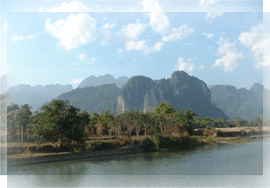 |
|
History
of Vang Vieng
Nam
Xong, the main river of this district has its own
legend. According to the tales of Khounboulom Rajathirath,
King Fa Ngum defeated and governed Phai Naam the
capital city of Lane Xang Vientiane. Phra Nha Phao,
king of Phai Naam was captured on the Xong (bed)
and was to be taken to Luang Prabang for sentencing.
Along the way from Pai Naam to Luang Prabang, the
troops had pass through Bane Thine Heng and Pha
Tang. When Pha Nha Phao was taken to Pha Tang, he
became ill and died.
|
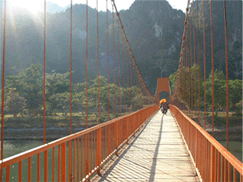 |
His
corpse was then sent to drift along the Houai Sida
river, as the villagers saw the corpse, they then
named the river Xong of Pha Nha Phao or Nam Xong
ever since 1356.
And
even before given the name Muong Xong, Vang Vieng
was also called Bane Thine Heng where the middle
land and Khom people spent their lives for many
generations. Then as time passed, Thai Phouane,
the Xieng Khouang people settled here and most of
the people in Vang Vieng today are Xieng Khouang.
|
| When
the black warriors and Siamese troops invaded Lane
Xang Kingdom in 1874, Thao Tengtai or Pha Nha Isane
Outaitesa Saysanaxongkham was born in 1850 in Houaphan
Thangha and Thanghok. He was the fourth child of Pha
Nha Gnom family and nephew of Pha Nha Soulintha. Thao
Tengtai was advised by his father to look for a peaceful
place for his people to live. |
|
Thao
Tengtai spent 22 years looking for a permanent
place to live before arriving in Bane Phone
Nhang located in the Thoulakhom area. They
stayed there for 9 years because Thao Tengtai
had to attend an administration training course
in Luang Prabang managed by the Siamese administration.
The chief of Thoulakhom was requested by Thao
Tengtai to look after his people within that
time.
After
completing the training course, he returned
to his people in Thoulakhom and said goodbye
to the chief of Thoulakhom. They then moved
upward passing through Bane Phone Nhang and
upstream through Nam Lik and Nam Xong river.
|
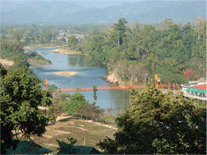 |
|
When
Thao Tengtai and his people arrived at Bane
Hine Khanmak, the present cement factory,
they spent a year building their town. But
they realized that the location of Muong Xong
was much better since it was located along
Nam Xong river. So they decided to construct
their homes and Thao Tengtai was nominated
to be the chief of the town.
From
1893 to 1899, when the kingdom of Laos was
under French administration, Muong Xong was
recognized as the town.
Pierre
Moring, a representative of the French government
and his assistant in Vientiane, officially
recognized the town in May 16, 1899 and nominated
Thao Tengtai or otherwise known as Pha Nha
Isane to be the chief of the town and changed
the name of Muong Xong to be called Vang Vieng.
Vang
Vieng is on the way to Luang Prabang from
Vientiane, so the king of Lane Xang Luang
Prabang and Lane Xang Vientiane often stopped
here to relax.
|
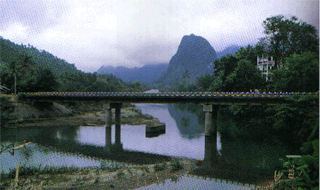 |
Vang
Vieng is now a tourist site for travelers
from Vientiane heading to Luang Prabang
along road No.13 north. When visiting
Vang Vieng one has to stop and see the
lovely nature of Pha Xang, Tham Jang,
Tham None, Phadeng, Pha Tang and much
more.
Wat
Done Hor is the oldest temple among
five temples located in Vang Vieng.
It was built by Pha Nha Outai in 1903.
There are 8 poles made by rocks, rocks
in six sections join each pole. In this
temple there is a big Buddha image,
and offering hall and a big stupa all
of which were built at the same time
as the main temple construction.
|
| |
|
|
|
The
Fable of Pha Tang Mount
Pha
Tang is alike a standing stupa that no one can climb up
to its top. It is the most attractive and strange mountain
in Vang Vieng because of its own unique shape created
by nature.
Generally
speaking about Pha Tang, people prefer to say Pha Tang
Vang Vieng since it is located closely to Bane Pha Tang
and located besides Nam Xong river.
No
one knows clearly about it as its history was not mentioned
in Vang Vieng history book. Many interesting fable of
Pha Tang has been only recited for fun since the old generations
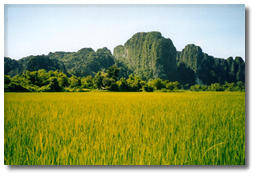 .
.
Old
reciting that once upon a time, there was a big man whose
name was called Thao Chethai. When he drank he can drink
seven pot of alcohol. He was stronger than ordinary people
and he worked as the farmer in Nam Xong rice field.
When
there was very heavy flooding, he was very angry with
the river, he found out the way to block the river, so
he carried big rocks to make embankment.
While
he carried the rocks to this existing place of Pha Tang,
his shoulder pole was broken because the rocks were too
heavy and one of the rock fell down to be as Pha Tang
at the present day. And other was fallen far away that
no one know where it is till the present time.
Old
saying that one of the rocks was fallen down over him,
so Thao Chethai and his dog were killed. Now we can see
the head of the dog on the top of this mount.
Anyone
who travels along the road No. 13 north, will alert their
eyes to see Pha Tang mount.
By
P. Phouangsava - Visiting
Muong Lao Magazine
